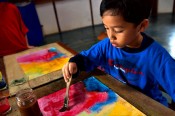 Bringing Love to Learning for a Lifetime
Bringing Love to Learning for a Lifetime Caring for All Stages of Life
Caring for All Stages of Life Jamie York Books, Resources, Workshops
Jamie York Books, Resources, Workshops Association for a Healing Education
Association for a Healing Education ~ Ensoul Your World With Color ~
~ Ensoul Your World With Color ~ Full-Time Teacher Education
Full-Time Teacher Education Transforming Voices Worldwide
Transforming Voices Worldwide Quality Education in the Heartland
Quality Education in the Heartland Middle School Science With Roberto Trostli
Middle School Science With Roberto Trostli Flexible preparation for your new grade
Flexible preparation for your new grade Space speaks. Its language is movement.
Space speaks. Its language is movement. Everything a Teacher Needs
Everything a Teacher Needs Waldorf Training in Australia
Waldorf Training in Australia Apply Today: New Cohort Starts Nov. 2025
Apply Today: New Cohort Starts Nov. 2025 Train to Teach in Seattle
Train to Teach in Seattle
 Summer Programs - Culminating Class Trips
Summer Programs - Culminating Class Trips Great books for Waldorf Teachers & Families
Great books for Waldorf Teachers & Families Bay Area Teacher Training
Bay Area Teacher Training Immersive Academics and Arts
Immersive Academics and Arts The Journey is Everything
The Journey is Everything Roadmap to Literacy Books & Courses
Roadmap to Literacy Books & Courses Waldorf-inspired Homeschool Curriculum
Waldorf-inspired Homeschool Curriculum
Would you like to become a sponsor?
Waldorf News

Imhoff Waldorf School: Bringing Learning to Life
September 16, 2013
Imhoff Waldorf School (Cape Town, South Africa) was started in 1996 by a group of parents who believed in alternate education with roots in conservation of the environment. Waldorf education was the nearest form of curriculum embracing these ideas. The school is situated on an old and mostly undeveloped farm called Imhoff Farm. The school grounds are untamed, resulting in a natural and appealing sense of freedom. There are goats, camels and peacocks on the farm and there are rabbits, porcupines (we see mostly tracks and quills), baboons, scorpions, insects and the occasional snake! Today, in 2012, both the Imhoff Farm and our Waldorf School have managed to maintain their natural and rural feel. We hope in future developments that this natural spirit be preserved as it has become such an important part of the Imhoff Waldorf School. More »

No-test, No-tech School: Waldorf takes hands-on approach to learning—Waldorf on CNN with Dr. Gupta
September 9, 2013
Parents all over, they wring their hands about the state of schools—and there’s this big debate about high stakes testing. Does it hurt creativity, or does it actually offer accountability? So, imagine a school then with no tests, no technology, not even traditional textbooks. It’s the Waldorf Way. In a Waldorf school learning looks different. Instead of writing a book report on a literature lesson, they take that same story and create a play or a song. When you’ve done it, it really comes into your soul and into your limbs that you never forget. It’s true that most people learn by doing and that’s the innovative approach of a Waldorf education. —Dr. Sanjay Gupta More »

Mandala: The Encircling Round Holds Sway
September 8, 2013
Mandala design and construction can include study of traditional art, work with symmetry, pattern, metamorphosis, signs and symbols, color, dream imagery, festival and curriculum themes. Working with the various divisions of the circle and freehand geometry is most helpful in this regard and it encourages our innate sense for form to become more conscious to us. The art of mandalas is a picturing and a self-portraying of the universal human being toward an individual entity. This is why it is so effective for work with children, young people and adults of all ages (fig. 6). It is an ordering of elements and a shaping of awareness toward the end of creating a sacred space, a consecrated place in which the self can experience itself as an image of the world and the world can live in a picture of the self. The history of the mandala is an ever-transforming search for a true portrait of the universal Self. More »

Gamot Cogon School: We Have a Dream
August 26, 2013
We knew Jerry Paul was from a very poor family, but we didn’t know just how poor until the day he came to school with wet clothes. When his teacher inquired about his dampness, he replied that his clothes were washed the day before and didn’t have enough time to dry overnight—he had nothing else to wear. There are many other children from economically deprived families who come to Gamot Cogon, a Waldorf-inspired school in Zarraga, Iloilo, Philippines. In fact, at least 40% of the children come from the surrounding rural villages comprised of large families living well below the poverty line. Many of the people find seasonal work as farmers, tricycle drivers or laborers earning around $50 a month and supporting an average of three to four children. Gamot Cogon Institute (GCI) was founded in 2005 by James Sharman, Teresa Jalandoni, Nicanor Perlas and a few others interested in the ideas of Rudolf Steiner. The first project of the initiative was to setup a Steiner School which was then named Gamot Cogon School. The school started with only four students in class three and one teacher. However, each year more and more children kept finding us so that by this school year, 2011-12, we have 150 children from Kindergarten to Class 9, with 12 full-time and three part-time teachers. More »

The eZombie at Your Table: A quiet cry
August 5, 2013
More suited to a sci-fi flick than reality, a startling epidemic of young people with smartphone-addled brains is on the rise, and the long-term consequences might be far worse than you or I could imagine. Reporting that one in five students are addicted to their smartphones, South Korea, the world's most tech-savvy nation, is aggressively tackling the problem, establishing more than 100 Internet addiction camps. As the number of young Smartphone users escalates around the globe, educating children and parents about the effects of this increasingly prevalent drug of the future is imperative. South Korean medical researchers released a recent report that illuminates the experiment in which we are all unwitting participants. Neuroscientists there reported a rise in digital dementia -- the tendency of the young to be so obsessed with smartphones that they can't remember phone numbers, produce legible handwriting, or look people in the eye, all signs of a type of brain damage. In a nation where 20 percent of 10 to 19-year-olds spends seven hours a day on smartphones and tablets, exposures are the highest in the world, and reports of lop-sided brain development are increasing. According to the Korean Ministry of Science, the country has more digital devices than people, with many children beginning to use devices as toddlers. Psychiatrist Dr. Byun Gi-Won, of the Balance Brain Center in Seoul, South Korea, explained, "Young people who are heavy technology users are likely to have a properly developed left hemisphere of the brain while the right hemisphere will be unused and underdeveloped." More »
 Recent Jobs
Recent Jobs
View more jobs »
 Newsletter Archive
Newsletter Archive
 Join the Mailing List!
Join the Mailing List!
Stay Connected…
Each week receive the Waldorf News Weekly Update, full of news, events, and more. Keep abreast of what's happening with Waldorf education.
 RSS Feeds
RSS Feeds